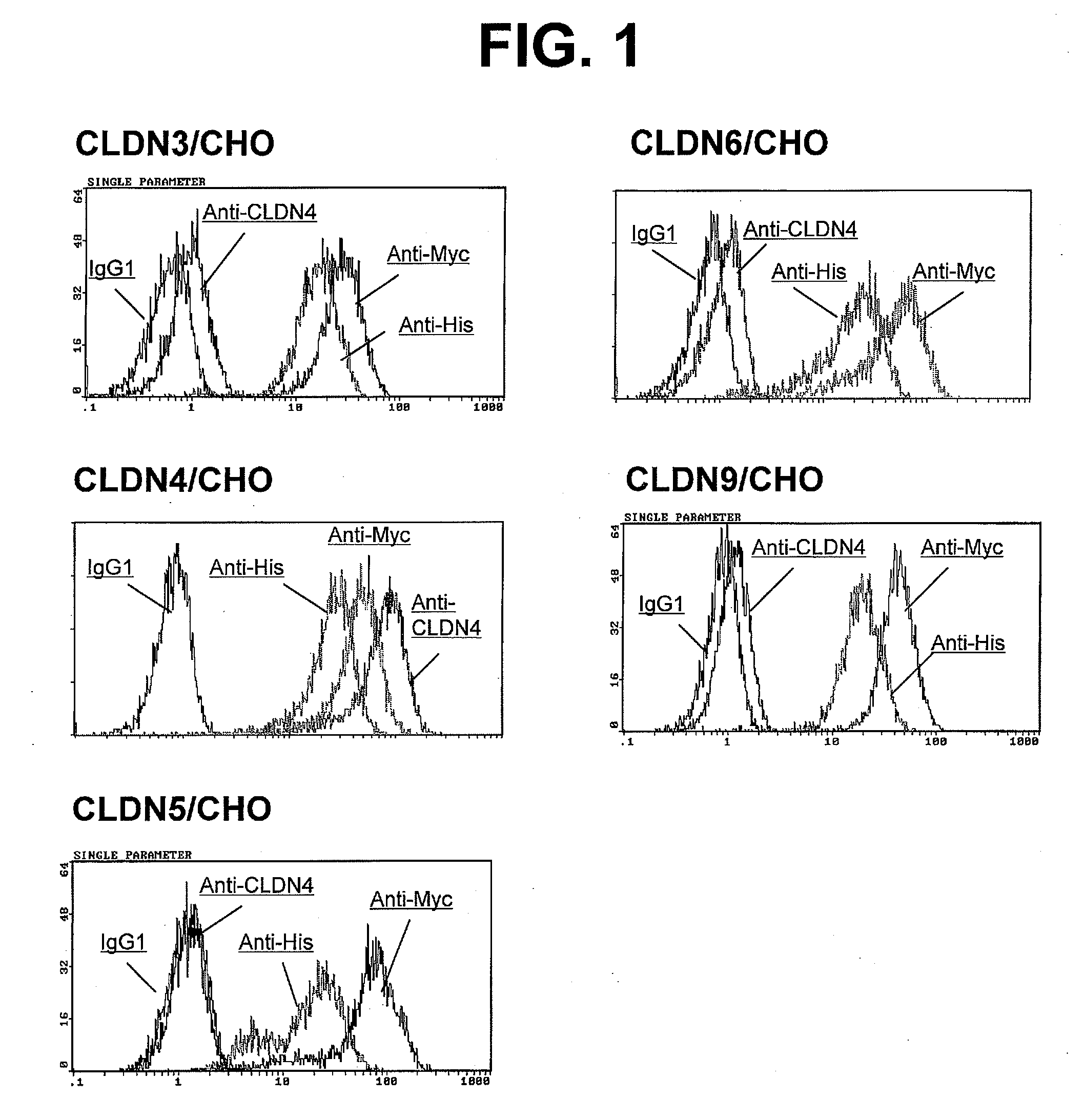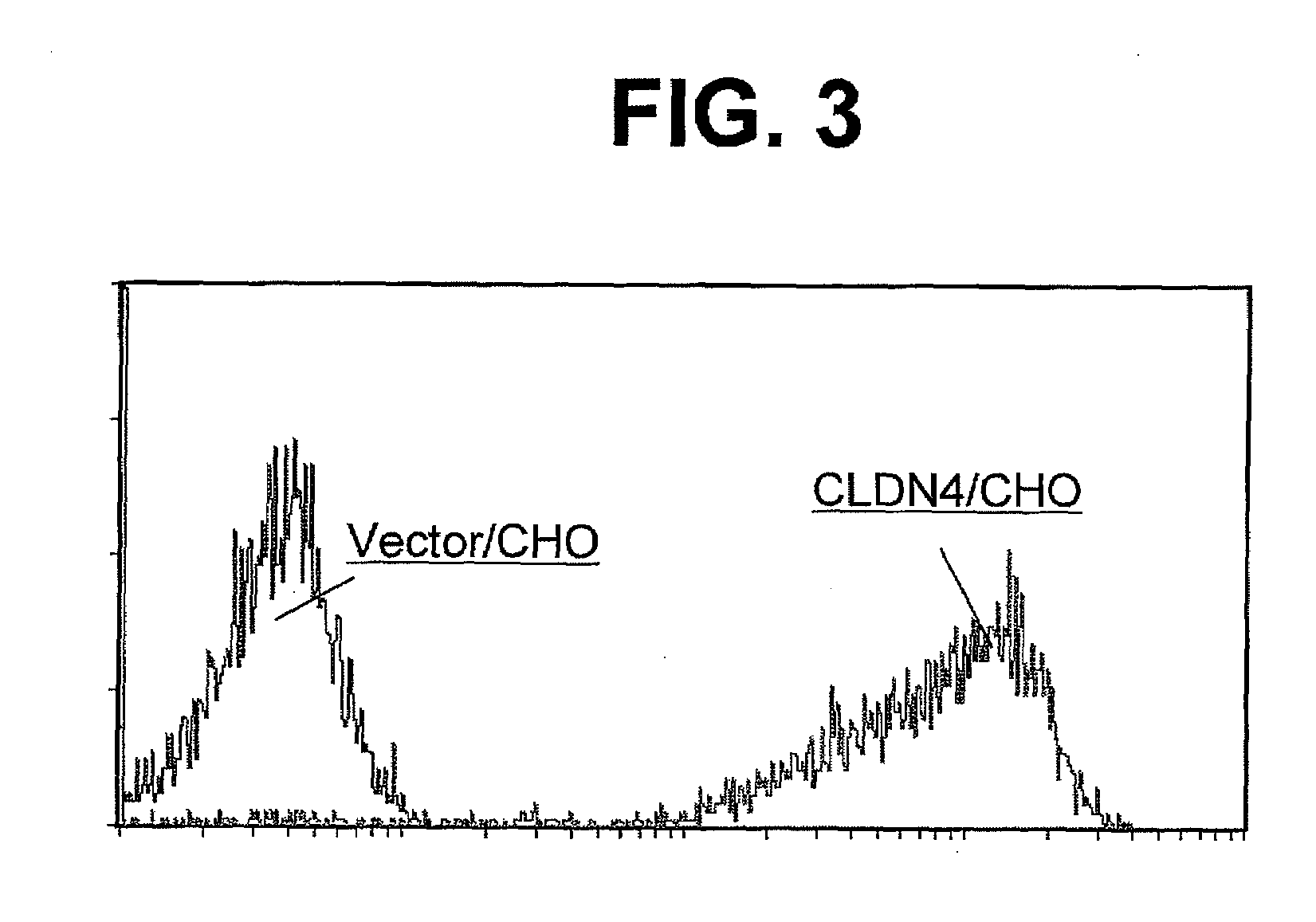Anti-claudin-4 antibody
a technology of anti-claudin and antibody, which is applied in the field of monoclonal antibodies or antibody fragments, can solve the problem of unconfirmed specificity of anti-claudin4 antibodies
- Summary
- Abstract
- Description
- Claims
- Application Information
AI Technical Summary
Benefits of technology
Problems solved by technology
Method used
Image
Examples
example 1
Construction of CLDN-myc / His Gene-Introduced CHO Cell Clone
[0334](1) CLDN4-myc / His Gene-Introduced CHO Cell Clone
[0335]PCR was carried out by preparing 100 μl of a reaction solution containing 100 ng of a plasmid having the human CLDN4 gene (SEQ ID NO:1) registered with Japan DNA Data Bank (AK126315) as the template, 10 μl of 10×KOD buffer 1, 10 μl of 2 mmol / l dNTP, 4 μl of 25 mmol / l magnesium chloride, 1 μl of 1 μg / μl of each of the primers comprising the nucleotide sequences represented by SEQ ID NO:9 and SEQ ID NO:10 and 1 μl of KOD polymerase (manufactured by TOYOBO). Regarding the reaction conditions, after denaturation treatment at 96° C. for 3 minutes, reaction was carried out by 30 to 40 cycles, each cycle consisting of reaction at 94° C. for 1 minute, reaction at 55° C. for 1 minute and reaction at 72° C. for 1 minute, followed by reaction at 72° C. for 7 minutes. Hereinafter, unless otherwise indicated, a gene encoding a fusion protein in which myc / His was added to the C-t...
example 2
Preparation of Anti-CLDN4 Monoclonal Antibody
(1) Preparation of Immunogen
[0347]Pancreatic cancer cell line Capan-2 (ATCC HTB-80) or CLDN4 / CHO was cultured for 3 to 5 days and peeled off using a 0.02% EDTA solution (manufactured by Nacalai Tesque) or a cell scraper. The cells were suspended in PBS and prepared to the number of cells of 6×106 to 1×107 per animal,
(2) Immunization of Animal and Preparation of Antibody Producing Cell
[0348]Capan-2 cell prepared in Example 2-(1) was administered together with 1×109 cells of pertussis vaccine (manufactured by Chiba Serum Institute) to 3 animals / group a BXSB mouse of 6 weeks old (manufactured by Japan SLC). One week after the administration, the cells were administered once a week, 4 times in all, and blood was partially collected from the fundus of the eye of the mice. By carrying out the fluorescent antibody staining shown in Example 2-(3), its blood antibody titer was measured by ABI 8200 Cellular Detection System (manufactured by Applied...
example 3
Examination of Reactivity of Anti-CLDN4 Monoclonal Antibodies
(1) Detection of CLDN3 or CLDN4 by Western Blotting Using Anti-CLDN4 Monoclonal Antibodies KM3900 and KM3907
[0358]SDS-polyacrylamide electrophoresis was carried out by preparing respective cell extracts from 5×104 cells of CLDN4 / CHO, vector / CHO, pancreatic cancer cell lines Capan-2 (ATCC HTB-80) and HPAF-II (ATCC CRL-1997). Thereafter, they were transferred onto a PVDF membrane (manufactured by Millipore), and the membrane was blocked with BSA-PBS. After removing the BSA-PBS, a commercially available positive control antibody, anti-CLDN4 monoclonal antibody 3E2C1 (manufactured by Zymed), a culture supernatant of the hybridoma KM3900, a culture supernatant of the hybridoma KM3907 or a negative control antibody KM511 (anti-G-CSF derivative antibody) [Agric. Biol. Chem., 53, 1095 (1989)] was allowed as the primary antibody to react with the membrane at 4° C. overnight. The membrane was thoroughly washed with Tween-PBS, and pe...
PUM
| Property | Measurement | Unit |
|---|---|---|
| concentration | aaaaa | aaaaa |
| pH | aaaaa | aaaaa |
| pH | aaaaa | aaaaa |
Abstract
Description
Claims
Application Information
 Login to View More
Login to View More - R&D
- Intellectual Property
- Life Sciences
- Materials
- Tech Scout
- Unparalleled Data Quality
- Higher Quality Content
- 60% Fewer Hallucinations
Browse by: Latest US Patents, China's latest patents, Technical Efficacy Thesaurus, Application Domain, Technology Topic, Popular Technical Reports.
© 2025 PatSnap. All rights reserved.Legal|Privacy policy|Modern Slavery Act Transparency Statement|Sitemap|About US| Contact US: help@patsnap.com



